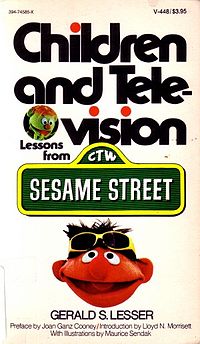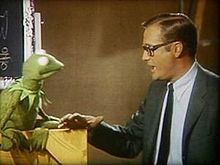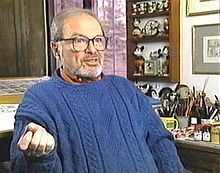- Children and Television: Lessons from Sesame Street
-
Children and Television: Lessons from Sesame Street 
Author(s) Gerald S. Lesser Country United States Language English Genre(s) Non-fiction Publisher Vintage Books Publication date 1974 Media type Mass-market paperback Pages 291 ISBN 9780394481005 OCLC Number 1289005 Dewey Decimal 791.457 LC Classification PN1992.77.S43 L4 Children and Television: Lessons from Sesame Street is a non-fiction book written by Gerald S. Lesser, in which he describes the production of Sesame Street, and the formation and pedagogical philosophy of the Children's Television Workshop.
Contents
Background
 Gerald Lesser (with the Muppet Kermit), in a 1968 promotional pitch reel shown to executives of educational TV stations.
Gerald Lesser (with the Muppet Kermit), in a 1968 promotional pitch reel shown to executives of educational TV stations.
Gerald S. Lesser was a Biglow Professor of Education and Developmental Psychology at Harvard University. He studied how social class and ethnicity interacted with school achievement and was one of the first academics in the US who researched the effects that watching television had on children and their development. In 1963, he served as an academic adviser for the NBC educational program, Exploring.[1] In 1968, Sesame Street co-creator Lloyd Morrisett, whom he had met as a student at Yale University, asked Lesser to assist with the research of a new children's show he and producer Joan Ganz Cooney were developing, a show that eventually became Sesame Street.[2]
Lesser was initially skeptical about the potential of using television as a teaching tool. Eventually, he was named as the advisory board chairman of the Children's Television Workshop (CTW), the organization created to oversee the production and research of Sesame Street, and was the show's first educational director.[3] He was also skeptical about Cooney's qualifications as CTW's first director,[4] but Cooney later stated, "...I couldn't begin to measure how proud I am to be Gerry Lesser's colleague and how happy I am to know the pleasure of his company".[5]
In the summer of 1968, under what Sesame Street researchers Edward Palmer and Shalom Fisch called Lesser's "able leadership",[6] five three-day curriculum planning seminars were conducted in Boston.[7][8] The purpose of the seminars, attended by educational experts and the new show's writers and producers, was to ascertain which school-preparation skills to emphasize. According to writer Michael Davis, Lesser's skills at encouraging collegiality were evident during the seminars.[4] Writer Louise Gikow reported that the real friction occurred between the educators present. As Sesame Street songwriter Christopher Cerf reported, "...[Lesser] ran meetings better than anyone I've ever seen. He made everybody feel like they were important, that they got listened to, and that their work ended up in the final product".[9] Davis noted that the seminars also served as a "crash course in child development, psychology, and preschool education" for the show's producers and writers.[10] According to researcher Robert W. Morrow, Lesser understood that in order to bring research about child development into the production process of Sesame Street, a close working relationship had to be created between the researchers and the producers.[1] Davis credited Lesser's "informal, unpretentious, and collaborative" [11] manner with the creation of that close relationship.
As head of research on Sesame Street, Lesser came up with what he called "the CTW model". This model included having assumptions about how children learn from television, the use of high-quality production values, and establishing "an organization that fostered mutual confidence among its members".[12] Field research testing the effectiveness of each episode's content had to be conducted at preschools, prior to broadcast. The show's educational goals were measured after each episode aired to further evaluate the show's effectiveness.[13]
Lesser wrote Children and Television in 1974, early in the show's history, to evaluate the effectiveness of the CTW model, to explain what the show's writers, researchers, and producers were attempting to do, and to respond to criticism of Sesame Street. Lesser also explained the show's logic, its curriculum, and its pedagogy.[14] Writer Robert W. Morrow called Lesser's book "Sesame Street's most adept defense".[15] According to Morrow, Children and Television was the most complete explanation of the CTW's reasoning behind the show at the time, and a memoir of the show's development.[14]
Synopsis
Children and Television has four sections, "A Proposal", "Planning", "Broadcasting" and "Lessons from Sesame Street". The book also has a preface and an epilogue, written by Lesser, a foreword written by Joan Ganz Cooney, and an introduction by Lloyd Morrisett. Scattered throughout the book are cartoons drawn by children's author Maurice Sendak, who attended the 1968 seminars.[16]
 Maurice Sendak, author of the children's book, Where the Wild Things Are. Sendak was instrumental in the creation of Sesame Street, and attended Lesser's curriculum seminars in 1968.
Maurice Sendak, author of the children's book, Where the Wild Things Are. Sendak was instrumental in the creation of Sesame Street, and attended Lesser's curriculum seminars in 1968.
Lesser begins his book by describing the origin of Sesame Street and his part in it. He had been studying child development and how its concepts could be used to teach children; since 1961, he studied children's reaction to television and whether or not the medium could be used to teach them. In 1966, he was approached by Cooney and Morrisett to assist them in creating the new show's educational objectives and research goals, and he agreed despite his misgivings about the effectiveness of television as a teaching tool.
Sesame Street's audience included any child in the country who wished to watch it, but Lesser reports that the producers' original purpose was to reach the poor children of America. As Lesser stated, "If the series did not work for poor children, the entire project would fail".[17] Lesser is critical of the American public school system, and blames its failure to educate children on the lack of defined goals. When he wrote Television and Children, most American children received no preschool education. The first two chapters of the book detail the reasons for the "experiment"[18] of creating an educational television program like Sesame Street, especially in regards to its audience.
"Grownups never seem to understand anything by themselves, and it is tiresome for children to be always and forever explaining things to them". Antoine de Saint-Exupéry, The Little Prince. Gerald Lesser used this quote to begin the second section of Children and Television. He introduced many of his sections and chapters with pertinent quotes.
Lesser opens the section on "Planning" by relating how many of the cast and crew were recruited: executive producer David Connell, producer Sam Gibbon, head writer Jon Stone, producer and writer Matt Robinson, Jim Henson, composer Joe Raposo, and actors Loretta Long, Bob McGrath, and Will Lee. Lesser also recounts the process of hiring head researcher Edward L. Palmer and those involved with community outreach. The producers of the new show spent eighteen months planning, something that was unprecedented in children's television. Lesser extensively describes the series of curriculum seminars that took place at Harvard University and in New York City in the summer of 1968.
These chapters outline the philosophy behind Sesame Street. The show's creators made assumptions about teaching and held the unconventional view that learning can be unintentional and enjoyable. Finally, they decided that although Sesame Street was set in an urban setting, they would avoid depicting more negativity than what was already present in the child's environment. As Lesser states, "With all its raucousness and slapstick humor, Sesame Street became a sweet show, and its staff maintains that there is nothing wrong in that".[19]
The researchers developed a "Writer's Notebook" for the show's writers and producers to serve as a bridge between curriculum goals and script development. Lesser connects the show's production techniques—including the use of music, humor (especially slapstick humor), and animation—with educational goals. Lesser emphasizes the importance of characters, both human and Muppet, to sustain children's attention. According to Lesser, Sesame Street combines four elements to sustain attention: Muppets, the cast of live adults and children on the set, animation, and live-action film.
According to Lesser, children's reactions to educational television was ignored; this marked the first time that they were studied to evaluate and improve the show's content and efficacy. Lesser reports that approximately 10-15 percent of the CTW's initial two-year budget of $8 million was spent on research. He relates the priorities for pre-production research, which he called "summative evaluation". Using outside research groups like the Educational Testing Service (ETS), the Workshop wanted to ascertain if watching the show made any difference. They were particularly interested in comparing the show's effect on children from different socio-economic groups, and if viewing conditions affected its effectiveness.
As Lesser states, "This became the first time in television's 25-year history that child-watching was systematically applied over a sustained period to the design of a televised series for children".[20] Lesser describes the new methods researcher Edward Palmer created to study the effects Sesame Street had on its young viewers, mostly notably the "distractor", a slide projector placed next to a television set and adjusted to change slides every eight seconds. The researchers recorded when children in their study moved their attention away from the television to the projector, and the data collected were analyzed. Segments were removed based upon the information gathered. "This was the first time in television's history that the children themselves would be listened to with care as a television series for them was designed and broadcast", Lesser states.[21]
Lesser begins the section on "Broadcasting" relating the origin of the show's name. As he puts it, "...We were forced to select the name we all liked the least".[22] Lesser reports that the show's premiere on November 10, 1969 was met with a large amount of acclaim and good reviews, but there were some negative reviews and criticism. These he recounts and addresses in great detail in the chapter entitled "Criticism". He includes the criticism of approximately thirty groups and individuals, demonstrating the essence and range of the critics' arguments.
Lesser describes the research about the long-term effect of Sesame Street. He reports that the show was watched by three to four million viewers by the middle of its first season, and breaks down the viewership into categories. According to Lesser, ratings remained consistently high. Lesser also describes the testing used by ETS, which found positive differences after the first three weeks of the show's first season. They found that the children who watched the most learned the most. The final section of Lesser's book, "Lessons from Sesame Street", summarizes what the creators and researchers were attempting to do. As Lesser states, "Here is Sesame Street's main lesson: It deliberately uses television to teach without hiding its educational intentions and yet it attracts a large and devoted audience of young children from all parts of the country".[23]
Citations
- ^ a b Morrow, p. 58
- ^ Palmer & Fisch, p. 8
- ^ Davis, p. 118
- ^ a b Davis, p. 119
- ^ Cooney, Joan Ganz. "Foreword", in Lesser, p. xix
- ^ Palmer & Fisch, p. 3
- ^ Finch, Christopher (1993). Jim Henson: The works: The art, the magic, the imagination. Random House: Random House. p. 53. ISBN 0-6794-1203-4.
- ^ Lesser, Gerald S; Joel Schneider (2001). "Creation and evolution of the Sesame Street curriculum". In Fisch, Shalom M. "G" is for growing: Thirty years of research on children and Sesame Street. Mahweh, New Jersey: Lawrence Erlbaum Publishers. p. 27. ISBN 0-8058-3395-1.
- ^ Gikow, Louise A (2009). Sesame Street: A Celebration— Forty Years of Life on the Street. New York: Black Dog & Leventhal Publishers. p. 154. ISBN 978-1-57912-638-4.
- ^ Davis, p. 143
- ^ Davis, p. 117
- ^ Lesser, p. 239
- ^ Davis, pp. 117-118
- ^ a b Morrow, p. 151
- ^ Morrow, p. 150
- ^ According to Davis (p. 141), director and producer Jon Stone reported that Sendak's cartoons, which Stone later called "X-rated" and dealt with "basic themes of sex and violence", were created to vent Sendak's frustration with the seminars, which he found boring and long-winded.
- ^ Lesser, p. 8
- ^ Lesser, p. 19
- ^ Lesser, p. 95
- ^ Lesser, p. 154
- ^ Lesser, p. 162
- ^ Lesser, p. 168
- ^ Lesser, p. 234
Bibliography
- Davis, Michael (2008). Street Gang: The Complete History of Sesame Street. New York: Viking Press. ISBN 9-7806700-1996-0
- Lesser, Gerald S. (1974). Children and Television: Lessons From Sesame Street. New York: Vintage Books. ISBN 0-3947-1448-2
- Morrow, Robert W. (2006). Sesame Street and the Reform of Children's Television. Baltimore, MD: Johns Hopkins University Press.
- Palmer, Edward L. and Shalom M. Fisch (2001). "The beginnings of Sesame Street Research". In "G" is for growing: Thirty years of research on children and Sesame Street, Fisch, Shalom M. and Rosemarie T. Truglio, eds. Mahwah, New Jersey: Lawrence Erlbaum Publishers. ISBN 0-8058-3395-1
Sesame Street General Sesame Workshop • History • Format • Educational goals • Influence • Human characters • Animated characters • Sesame Street Muppets • MediaPeople Production Sesame Street research • International co-productions of Sesame Street • MusicLiterature Children and Television: Lessons from Sesame Street • The World According to Sesame Street • Street Gang: The Complete History of Sesame StreetRelated Categories:- 1974 books
- American non-fiction books
- Books about television
- Sesame Street
Wikimedia Foundation. 2010.
